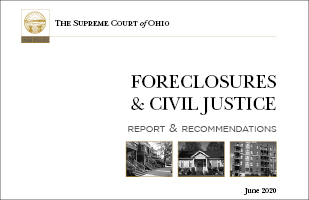Supreme Court Foreclosure Guide Touts Mediation, Tech

A new guide promotes mediation and offers foreclosure caseload statistics for every Ohio county during this pandemic.

A new guide promotes mediation and offers foreclosure caseload statistics for every Ohio county during this pandemic.
The Ohio Supreme Court’s guide on home foreclosure disputes promotes mediation and technology as major avenues where local courts can forge remedies between homeowners and lenders.
“Working together and working wisely has served Ohio courts well this year as our response to the coronavirus pandemic. Our foreclosure guide continues that trend,” Chief Justice Maureen O’Connor said.
“The virus has made home foreclosure a real threat to Ohio families as unemployment soars.” she said. “Mediation coupled with remote distancing technology will go a long way toward helping judges and magistrates find solutions for all sides.”
The guide – “Foreclosures & Civil Justice: Report and Recommendations” -- includes mortgage statistics for every Ohio county, including the percentages backed by federal programs and subject to a current federal moratorium.
The guide was created by the Supreme Court’s Office of Court Services with recommendations provided by a working group of 28 judges, magistrates, attorneys, legal aid professionals, mediators and Ohio Supreme Court staffers.
They analyzed caseloads as well as foreclosure statistics and solutions from the 50 states and came up with strategies for dealing with what Court Services Director Stephanie Nelson called “the coming influx of foreclosure filings.”
“Many cases of all types have been delayed due to the pandemic as courts have concentrated on their most essential matters,” Nelson said. “This situation has pushed back many foreclosure actions, but this backlog will have to be dealt with through case management and mediation.”
Among the recommendations:
- Building capacity in mediation services so that skills can be increased for visiting judges, magistrates, volunteer mediators, dispute resolution students, court personnel, local bar association members, and law students.
- Enhancing technology and access to justice, including use of equipment purchased with the $6 million provided this past spring by Chief Justice O’Connor from her budget. Courts in 87 of the 88 counties have been equipped with cameras, microphones, online platforms, video conferencing, software, and hardware for use in remote proceedings.
- Making changes in how civil cases are conducted, including limiting the number of parties, minimizing on-site witness testimony, and using documentary evidence as long as both parties agree to expedite cases.
- Increasing data reporting to the Supreme Court, including asking courts to track the effectiveness of mediation sessions in easing the backlog of pending foreclosure cases statewide.
“I was honored to be asked to serve with a very capable group of professionals with extensive experience in foreclosure and creditor-debtor cases,” said Highland County Common Pleas Judge Rocky Coss, a member of the recommendation panel.
“The report offers a number of tools that the courts, lawyers, parties, mediators and others can use to deal with the anticipated increase in filings of foreclosure cases in Ohio.”
Judge Coss predicted that “allowing expedited training of mediators for foreclosure cases will be very beneficial.”
The initiative “will require more mediators trained in foreclosure mediation, which can be very different from other civil cases,” he said.


